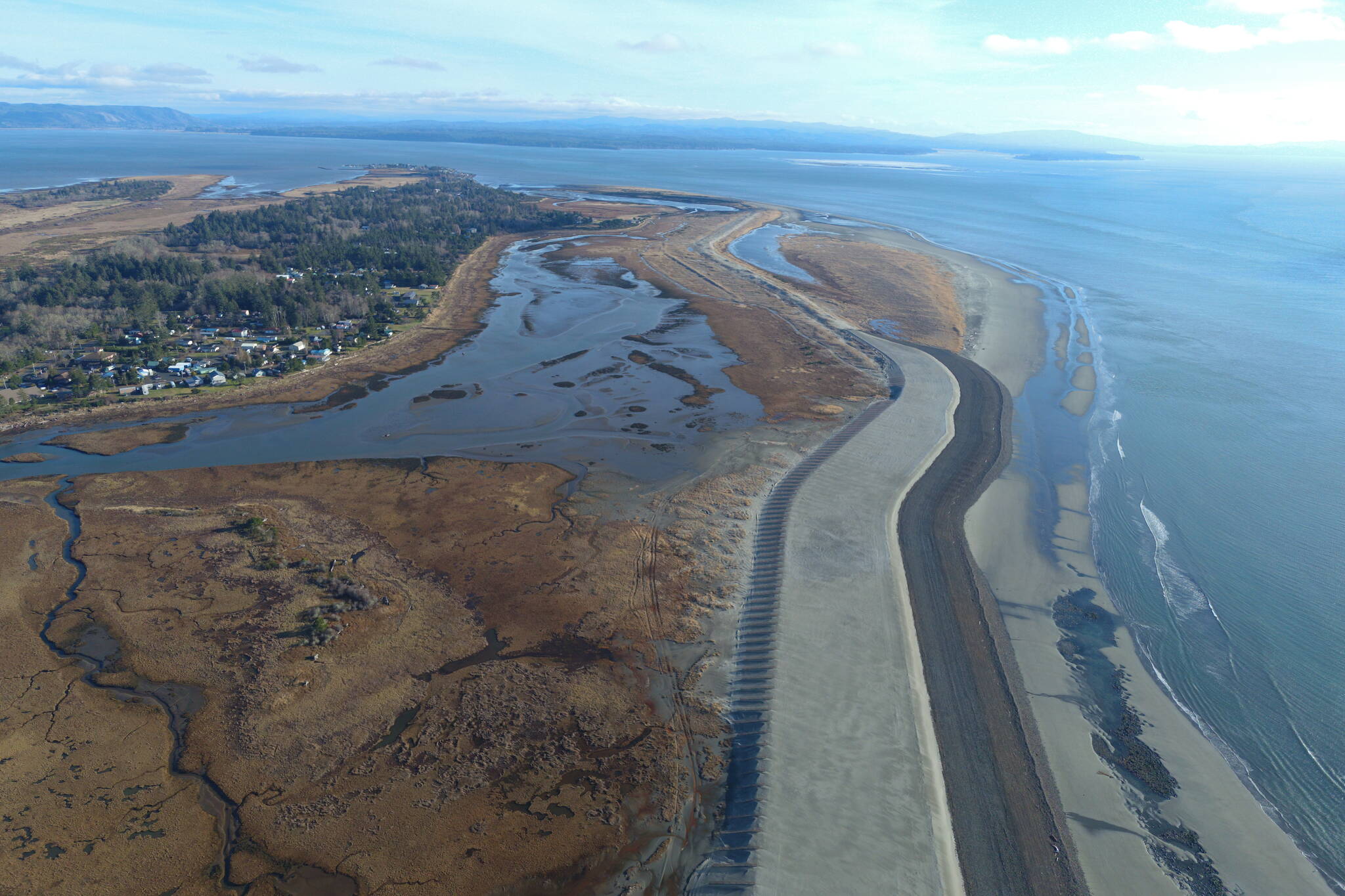An emergency project to reinforce a berm protecting coastal wetlands and tribal land on the Tokeland Peninsula was completed in December 2022 before heavy winter storms began roaring down the coast.
The $40 million project was one of the Army Corps of Engineers’ largest in the country, and was funded by a federal grant for disaster relief projects.
“Between 2018 and 2020, the berm was basically eroding at a rapid pace,” said Larissa Pfleeger-Ritzman, director of Natural Resources Department for the Shoalwater Bay Indian Tribe in an interview. “It eroded all that soft shore in front of it.”
Heavy winter storms in 2018 and 2020, defined as “extraordinary,” severely accelerated the requirement for replenishment of the dune sand berm, according to the project report. The tribe reached out to the Corps of Engineers in January of 2021 with an urgent request for assistance in reconstruction of the barrier.
“We had to declare an emergency for them to respond to those winter events,” Pfleeger-Ritzman said.
Capt. Aurora Deangelis-Caban, project manager for the Corps of Engineers’ Seattle District, praised cooperation between the Shoalwater Bay Indian Tribe, the Corps of Engineers, and the various state and federal agencies in getting the project done in a rapid and safe fashion.
A critical need
The berm, which had been constructed in 2013, helped protect the Shoalwater Reservation lands behind it from the wearing action of the ocean waves, which has steadily eroded parts of the coast in that region, Pfleeger-Ritzman said, referencing maps showing the coast from decades ago, now much eroded from its shape in the past.
“It used to have protection,” Pfleeger-Ritzman said. “There was a large, wide beach.”
The tribal government had to declare an emergency in order to make the project eligible for funding, Pfleeger-Ritzman said, and the money was allocated in January 2022. Of the $69 million designated for projects in Washington state, $40 million of it would go toward the berm — $39,404,700 in precise terms, with $29,225,000 allotted for the construction itself, according to the report.
“The compressed timeline resulted in many challenges for the project, but through dedicated perseverance, the U.S. Army Corps of Engineers’ Seattle District and Omaha District’s rapid disaster and infrastructure team, with the collaborative support from the Shoalwater Bay Tribe, Shoalwater Bay Tribe biologist Larissa Pfleeger-Ritzman, the U.S. Fish and Wildlife Services, the U.S. Environmental Protection Agency and Washington state Department of Ecology, were able to navigate any challenges to complete the project within budget on time,” Deangelis-Caban said in an email.
About 4,000 feet of the berm in particular needed some attention, Pfleeger-Ritzman said; that section was taking the brunt of the storm waves and was badly eroded. Emergency repairs had taken place in the winters before but the earthwork was in dire shape, Pfleeger-Ritzman said.
“That’s the only part that had been affected by storms,” Pfleeger-Ritzman said. “That’s what they focused on this year.”
The project would restore, widen and reinforce the berm with cobble, or rocks of a certain size, to help better neutralize and reflect the energy of the ceaseless ocean. The cost of the cobble itself — both the rock and the equipment to move it — helped drive a big part of the price tag, Pfleeger-Ritzman said.
“The biggest cost on this project is fuel and cobble,” Pfleeger-Ritzman said. “Cobble is expensive.”
Getting it rolling
The Corps of Engineers’ Seattle District worked with their Omaha District to make the most of the Omaha District’s experience in putting together rapid response projects, according to the Corps’ news release.
Environmental Chemical Corporation was the primary subcontractor on the project, selected by the Corps of Engineers’ Omaha District. ECC, in turn, subcontracted to Rognlin’s, Inc., Ross Island Sand & Gravel Co. and Jacobs Solutions.
Prep work began in late June, Pfleeger-Ritzman said, as contractors built the temporary road to run the trucks up and down.
“It was probably the most complicated project because of the roadway and the overwater access,” Pfleeger-Ritzman said.
Endangered species such as western snowy plovers and streaked horned larks also slowed construction as the rare species, found in numbers only in the dozens statewide, chose that particular beach to nest on, which required work stoppages.
“This beach is one of three that has a breeding population,” said Pfleeger-Ritzman. “There’s less than 100 plovers in Washington.”
Members of the public wandering onto the worksite, driven perhaps by curiosity, also caused stoppages, Pfleeger-Ritzman said.
“We had to go out and clear the area before they could do anything,” Pfleeger-Ritzman said. “We had a lot of problems with public trespass this year.”
The project wrapped in the last days of 2022 as contractors cleared the site, removing the roadway they’d used and restoring the area to its previous condition. It should be five years before the barrier requires replenishment, Pfleeger-Ritzman said.
“They have worked with us to save our Tribal Reservation from rising sea waters for all of our Tribal members who live here now, and for all who will come after us,” said Chairwoman Charlene Nelson of the Shoalwater Bay Indian Tribe in a Corps of Engineers news release.
Contact reporter Michael S. Lockett at 757-621-1197 or mlockett@thedailyworld.com.



